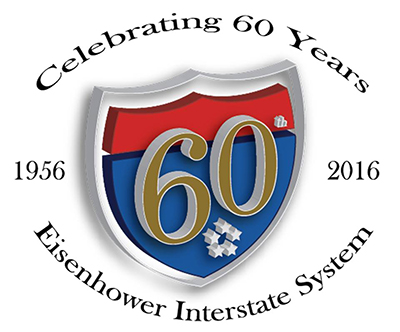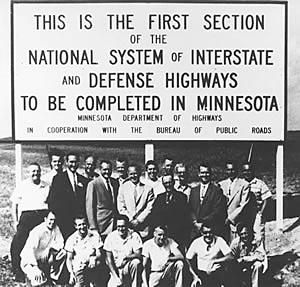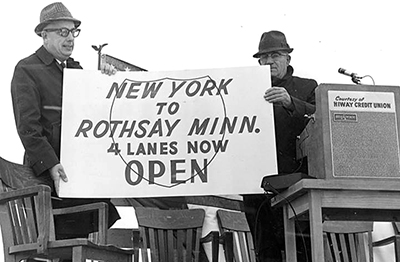By Sue Roe

This year marks the 60th anniversary of the interstate highway system. President Dwight Eisenhower’s 1956 legislation helped fund the network of roadways. |
Nothing changed the country’s landscape quite like the interstate highway system. It helped shape and grow the nation’s economy, quality of life, tourism and mobility. It changed the way goods and people move. This year marks the 60th anniversary of the landmark legislation that set in motion the “super highway.”
“Today, motorists and system users still rely on the interstate highways to get them from place to place. Minnesota’s economy is dependent on having interstates in good, usable condition so that products and services can get to market,” said Sue Mulvihill, deputy commissioner and chief engineer. “MnDOT is proud to operate and maintain nearly 1,000 miles of interstate highway, because we know how important this particular piece of the trunk highway system is to all Minnesotans. We will continue to manage the interstates to the best of our ability with the help of our partners and customers.”
Birth of the interstate
The idea for the interstate system was conceived as early as the first cars were getting stuck in mud roads, but it wasn’t until the Federal-Aid Highway Act and the Highway Revenue Act of 1956 that the 41,000 mile system gained momentum.

On-site workers who completed the state’s first section of the interstate highway system pose for this historic photo in 1958. The first section was eight miles of I-35 between Owatonna and Medford. MnDOT file photo |
President Dwight Eisenhower’s legislation provided more federal funding for road building in the four years after 1956 than in the previous 40. The Highway Trust Fund, created by the Highway Revenue Act, provided a 90 percent federal funding share for building the network and was a dedicated funding source.
The system was intended to connect metropolitan areas, cities and industrial areas. The legislation required the system to be designed to accommodate the traffic needs of 1975.
Eisenhower called for standard design to implement the program, including 12-foot lanes in each direction, 10-foot paved right shoulders, design speeds of 50 to 70 miles per hour, signs and materials.
According to the February 1957 edition of Minnesota Highway:
The main objective of freeways, expressways and similar high standard highways is to permit a free flowing, rapid traffic – not through excessive speed, but through sustained, safe speeds.
It will, for the first time in history, free the motorist from the delay and accident hazard of hundreds of grade intersections and traffic moving to or from the highway on connecting private driveways.
Their construction, alone, will provide direct and indirect employment for thousands of men for more than a decade….The freeways will become a dominant factor in settlement and community planning.
Target date for completion was 1972, but work continued long after. In early 1972, Minnesota completed 67 percent of the interstate system.
Minnesota planned 890 miles of the network. The original plan was for the development of I-35, I-90, I-94, I-494 and I-694. The project was estimated to take 13 years, but the last segment of I-35 wasn’t finished until 1992, completing the 1,593 miles from Laredo, Texas to downtown Duluth.
The last segment of I-90 opened in 1978 near Blue Earth. I-90 is the longest interstate highway in the country at more than 3,000 miles in 13 states.

The completion of I-94 near Rothsay, Minn., was celebrated in 1968. On the right is the late Frank Pawlak, then district engineer at Detroit Lakes. The man on the left is unidentified. MnDOT file photo |
The first section of interstate opened in Minnesota in 1958 on I-35 between Owatonna and Medford. The eight-mile section was hailed by Commissioner L.P. Zimmerman as “the start of a new era in the state’s highway facilities.”
“The tremendous amount of work which will follow on the interstate highways in our state will use the pattern established here in the construction of this first section which we are dedicating today,” he said at the opening ceremony. “In every sense of the word, this is a highway for the future.”
Zimmerman also said, “Uncounted hours of labor and devotion to duty have gone into what we see here today. Few of us realize how hard others have worked that this project may be completed and made available for the use of motorists.”
Beginning of careers
Steven Cray, a transportation specialist in the design office in District 7/Mankato, worked on many of the final segments of I-90 in his early years at MnDOT.
“My job was an entry level job doing basic grading inspection, performing gradations, proctors and density tests along with some surveying work. I was in my early 20s and knew that this was the connecting link, working long hours. I thought it was great that we were connecting the west and east coast, but was more worried what the next work day could bring,” he said.
Craig Felber began his MnDOT career in 1973 as an inspector and survey crew member in District 7. He worked on several sections of I-90 from Wells to Jackson from 1976 to 1978. He said crews worked 16-hour days, from 3 a.m. to sundown.
“Plant inspection normally started three hours before the first concrete left the plant to the job site. On days when bridge pours and mainline paving were done, traveling home for the night wasn’t worth it. Instead, we stayed and slept on the project site,” Felber said.
He remembers the last concrete batched and poured in 1978.
“The last concrete to be placed, that represented east meeting west, was batched out of Blue Earth Ready Mix,” he said.
Part of the last batch was tinted gold to signify the completion.
Today, Felber works in project management in Mankato.
“To me, the construction of I-90 meant a beginning of a career, not the completion of an interstate,” he said.
Editor’s Note: Minnesota and the rest of the country celebrated the interstate system’s 50th anniversary in 2006. Find some of MnDOT’s coverage here: www.mndot.gov/library/interstate-50-anniversary.html.
In addition, read more details about the role MnDOT, and its predecessor, the Minnesota Highway Department, played in building the system at these links:
- State DOTs to mark 50th anniversary of the interstate highway system
- Grand ceremony celebrated completion of I-90 in Minnesota, nation
- Completing last section of I-35E in St. Paul posed major test for Mn/DOT
- Vintage vehicle display, speakers will mark interstate highway system’s 50th anniversary
- Vintage auto show, salute to employees mark interstate's 50th anniversary
- Interstate 94 becomes integral part of Twin Cities’ growth, dynamism
- Agents needed fortitude, patience to obtain rights of way for interstate system
- Fate, circumstances play out in history of the interstate system
- 50th anniversary of interstate highway system brings vision for its future
Here’s American Association of State Highway and Transportation Official’s You Tube video about the 60th anniversary.
|



